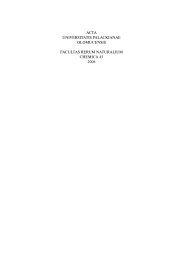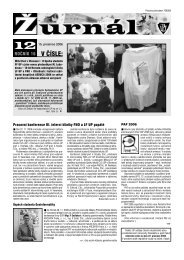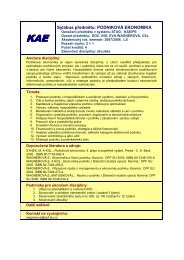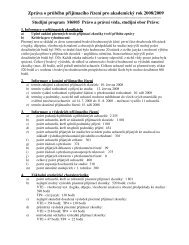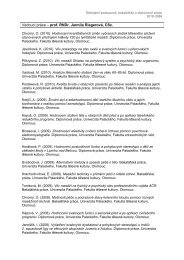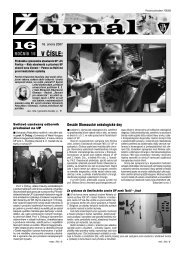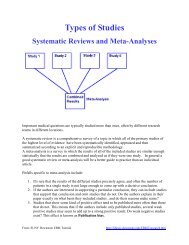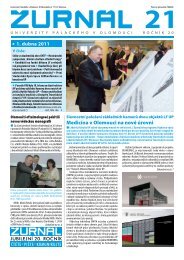ACTA UNIVERSITATIS PALACKIANAE OLOMUCENSIS GYMNICA ...
ACTA UNIVERSITATIS PALACKIANAE OLOMUCENSIS GYMNICA ...
ACTA UNIVERSITATIS PALACKIANAE OLOMUCENSIS GYMNICA ...
- No tags were found...
Create successful ePaper yourself
Turn your PDF publications into a flip-book with our unique Google optimized e-Paper software.
Acta Univ. Palacki. Olomuc., Gymn. 2004, vol. 34, no. 2 7BURNOUT IN PHYSICAL TRAINING TEACHERSA MACRO-PATH OF PROFESSIONAL BURNOUTMaria BrudnikBronisław Czech Academy of Physical Education, Cracow, PolandSubmitted in January, 2004The investigations were carried out in male and female physical training teachers from Cracow and Wieliczka, firstyearAcademy of Physical Educations students from Cracow (post-bachelor and extramural course) and participantsin three post-graduate courses (N = 256) between February and October, 2003. The syndrome was diagnosed basedon the MBI Maslach questionnaire. Empirical material was analyzed using variance analysis, the non-parametric testof difference significance and cluster analysis.More than one half of physical education teachers (58.6%) were demonstrated not to experience professionalburnout, while burned-out individuals accounted for 27.4% of the sample; the process of burnout was generally notdependent on the gender variable. Both the scope and intensity of burnout were found to be lower as compared togeneral education teachers. The initial reaction of physical training teachers to specific stress was a loss of job – relatedsatisfaction. The author failed to determine a burnout macro-path for physical training teachers; the missing T2segment requires elucidation based on a larger sample of material.Keywords: Professional burnout, physical training teacher.“It represents an erosion of values, dignity, spirit, and will – an erosionof the human soul. It is a malady that spreads gradually and continuouslyover time, putting people into a downward spiral from which it’s hard to reverse.”Ch. Maslach & M. Leiter, 1997, 17INTRODUCTIONThe term “burnout” was recognized as a scientificnotion less than 30 years ago, when it was employedsimultaneously and independently by a psychiatrist,Herbert J. Freudenberger, and a social psychologist,Christine Maslach (Tucholska, 2001).The burnout syndrome, which originally emerged asa social issue, has gained almost a score of conceptualizationsand operationalizations (see: Tucholska, 2003,19–55). The symptoms of burnout described by variousinvestigators have been collected by Cherniss (Noworol,1998, 215–216), and by other authors (see: Tucholska,2003, 38–39). In the literature on the subject, the mostpopular proposal is that presented by Maslach, who wasthe first to develop a coherent concept of the burnoutsyndrome and constructed a tool for measuring the phenomenon,i.e. the Maslach Burnout Inventory (MBI)(Maslach & Jackson, 1986).According to her concept, the burnout syndrome isthe reaction of the organism to chronic emotional stressresulting from the collapse of adaptation processes toone’s work environment. “It is a syndrome of physicaland mental exhaustion, which includes the developmentof negative concepts of ‘I’, a negative attitude towardsone’s work, a loss of emotions and contact in relationswith other people” (Maslach, 1978, in Noworol, 1989,124–125).Stress is a consequence of interpersonal contactsoccurring in various relations that result from one’swork contract. Social professions, such as nurses,physicians and teachers, are believed to be especiallyendangered with specific stress. Another group includesmanagers, high-level office workers and banking sectoremployees (Noworol, 2000), as well as individuals whohighly value professional work as such. These peopleare inclined to make special sacrifices; they often ignoretheir own needs and are at risk of deep disappointmentand frustration when faced with numerous stresses andan unfavorable work environment (Paines, 1993, in Tucholska,2003). Negative effects of burnout may spreadto other spheres of the life of the individual sufferingfrom the syndrome, leading to gradually increasing familyproblems, an escape into illness, substance abuse anddevelopment of psychogenic problems (Maslach, 1997,in Kliś & Kossewska, 1998).



